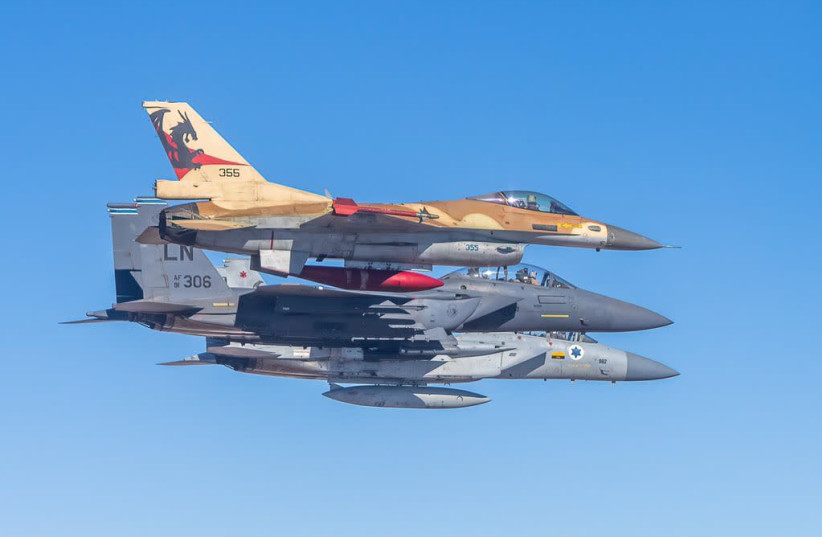The US and the IDF on Monday launched what has been described by both some Israeli and US officials as the most significant large-scale joint exercise to date, in a not-so-veiled message to Iran and other adversaries.
Though the Jerusalem Post was informed by multiple senior officials of the exercise weeks ago as being extremely significant, it was under the condition of not publicizing it until it was officially announced.
The exercise, known as “the Juniper Oak” drills, will involve thousands of forces, a dozen ships, significant numbers of attack and intelligence collection drones and 142 aircraft, including nuclear-capable bombers, and runs through this entire week.
These drills are meant to demonstrate and deepen integration between the US and Israeli militaries, a senior US defense official said, and come at a time of growing tension over Iran's nuclear program.
Critical for any potential strike on the Islamic Republic, the exercise will involve midair refueling aircraft, including the IDF said, the KC-46 aircraft which Israel will eventually receive from the US.

In addition, the IDF said that there would be special refueling drills at sea with the Sa’ar 5 ships, in order to increase the IDF’s maritime operational umbrella.
Moreover, the IDF said that the US High Mobility Artillery Rocket System (HIMARS) would be used along with various similar Israeli attack rockets. The HIMARS has around a 480-kilometer range and is said to be highly accurate within a range of 300 kilometers.
Although the drills will likely draw interest from Tehran, the US official said there would be no mockups of Iranian targets and that the exercises weren't oriented around any particular adversary.
"I do think that the scale of the exercise is relevant to a whole range of scenarios, and Iran may draw certain inferences from that," the official acknowledged.
"It's really meant mostly to kick the tires on our ability to do things at this scale with the Israelis against a whole range of different threats."
Earlier in January, the Post witnessed a range of American F-15s and Israeli F-35s taking off and maneuvering at Nevatim Air Base in the South in a drill relating to striking “deep targets” – a frequent Israeli euphemism for Iran.
November of last year saw yet another large joint drill involving the US and Israel.
What will the exercise include?
The exercises will include live-fire exercises and involve 6,400 US forces, many of which will be aboard the US aircraft carrier George H.W. Bush strike group. Some 450 troops on the ground in Israel, the official said.
Beyond B-52 bombers, the US aircraft will include F-35s, F-15s, F-16s and F-18s. Drills will take place over large distances, involving land, sea, air and space, the official said.
The planning for the exercises began only a couple of months ago, before Prime Minister Benjamin Netanyahu regained top office on December 29, but certainly sends his desired message of strength toward the Islamic Republic.
Israel has opposed US President Joe Biden's attempts to revive the 2015 Iran nuclear deal, concerned that it would fail to stop Tehran's development of a nuclear weapon.
But those negotiating efforts have been set aside for now while Washington pressures Iran to stop providing drones to Russia for use in its war against Ukraine and seeks to stop a crackdown on Iranian demonstrators.
Netanyahu expressed optimism about the converging positions of the two countries on Iran after recently meeting in Jerusalem with visiting US National Security Adviser Jake Sullivan.
A senior US official said on Monday that America's commitment to Israel's security was "ironclad."
"We have Israeli governments of one flavor or the other. They come and go. But what doesn't change is our ironclad commitment to Israel's security," the official said.
"So this is a sign that we continue to have Israel's back at a time where there's a lot of turbulence and instability across the region."
The Iranian nuclear program remains a concern
"I think it's fair to say Iran's nuclear program is more advanced now than it's ever been. Their breakout timelines are more compressed. Their knowledge and know-how has gone up," the official said. "So the challenge has gone up."
The official said the drills would show how the United States could effectively surge large numbers of battle-ready forces into the Middle East, even as Washington focuses on Russia's invasion of Ukraine and intensifying competition with China.
"As our adversaries and competitors are sizing up the US military, I suspect they will take note of our ability to do this because, frankly, no other military on Earth could do this," the official said. "Not while they're doing everything else that we're doing around the globe."
